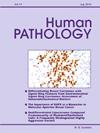Secondary pancreatic tumors in endoscopic ultrasound-guided fine-needle biopsy: Clinicopathologic characteristics and morphological diagnostic challenges
IF 2.6
2区 医学
Q2 PATHOLOGY
引用次数: 0
Abstract
Pancreatic metastases are rare and often difficult to diagnose, especially in limited tissue samples. However, accurate diagnosis is crucial for guiding appropriate clinical management. This study evaluates the clinical, radiologic, and pathologic features of pancreatic metastases, with a focus on morphological patterns that mimic common primary pancreatic tumors in endoscopic ultrasound-guided fine-needle biopsy (EUS-FNB) specimens. Among 1054 pancreatic neoplasms diagnosed over a nine-year period, 62 cases (5.9 %) were identified as metastases. The interval from initial diagnosis to pancreatic involvement ranged from synchronous presentation to 24 years. Most metastatic lesions (74 %, n = 46/62) presented as solitary masses, and 58 % (n = 26/45) were initially misinterpreted as primary pancreatic tumors on imaging. Histologically, 73 % (n = 45/62) were epithelial neoplasms, most commonly of renal origin (11 cases, 17.8 %), followed by lung (9, 14.5 %), cutaneous (6, 9.7 %), and Müllerian-derived tumors (6, 9.7 %). Among non-epithelial neoplasms, hematopoietic malignancies were most common (9, 14.5 %), followed by mesenchymal tumors (5, 8.1 %) and melanoma (3, 4.8 %). Several metastatic tumor types—including renal cell carcinoma, lung adenocarcinoma, breast carcinoma, gastrointestinal adenocarcinoma, Merkel cell carcinoma, and adult granulosa cell tumor—closely mimicked the histology of primary pancreatic neoplasms such as pancreatic ductal adenocarcinoma, neuroendocrine neoplasm, and solid-pseudopapillary neoplasms. Accurate diagnosis requires correlation with clinical history and a comprehensive ancillary workup, including immunohistochemistry. In summary, pancreatic metastases present a significant diagnostic challenge due to their overlap with primary tumors across clinical, radiologic, and histologic dimensions. A multidisciplinary diagnostic approach is essential to ensure accurate classification and optimal patient care.
内镜超声引导下细针活检继发性胰腺肿瘤:临床病理特征和形态学诊断挑战。
胰腺转移是罕见的,往往难以诊断,特别是在有限的组织样本。然而,准确的诊断对于指导适当的临床治疗至关重要。本研究评估胰腺转移瘤的临床、放射学和病理特征,重点关注内镜超声引导下细针活检(EUS-FNB)标本中模仿常见原发性胰腺肿瘤的形态学模式。在9年期间诊断的1054例胰腺肿瘤中,62例(5.9%)被确定为转移。从最初诊断到累及胰腺的时间间隔从同步表现到24年不等。大多数转移性病变(74%,n = 46/62)表现为孤立肿块,58% (n = 26/45)最初在影像学上被误认为是原发性胰腺肿瘤。组织学上,73% (n = 45/62)为上皮性肿瘤,最常见的是肾源性肿瘤(11例,17.8%),其次是肺源性肿瘤(9例,14.5%)、皮肤源性肿瘤(6例,9.7%)和胆管源性肿瘤(6例,9.7%)。在非上皮性肿瘤中,造血恶性肿瘤最为常见(9.14.5%),其次是间充质肿瘤(5.8.1%)和黑色素瘤(3.4.8%)。几种转移性肿瘤类型——包括肾细胞癌、肺腺癌、乳腺癌、胃肠道腺癌、默克尔细胞癌和成人颗粒细胞瘤——与原发性胰腺肿瘤(如胰腺导管腺癌、神经内分泌肿瘤和实体假乳头状肿瘤)的组织学非常相似。准确的诊断需要与临床病史相关和全面的辅助检查,包括免疫组织化学。总之,胰腺转移瘤由于其在临床、放射学和组织学上与原发肿瘤重叠,对诊断提出了重大挑战。多学科的诊断方法是必不可少的,以确保准确的分类和最佳的病人护理。
本文章由计算机程序翻译,如有差异,请以英文原文为准。
求助全文
约1分钟内获得全文
求助全文
来源期刊

Human pathology
医学-病理学
CiteScore
5.30
自引率
6.10%
发文量
206
审稿时长
21 days
期刊介绍:
Human Pathology is designed to bring information of clinicopathologic significance to human disease to the laboratory and clinical physician. It presents information drawn from morphologic and clinical laboratory studies with direct relevance to the understanding of human diseases. Papers published concern morphologic and clinicopathologic observations, reviews of diseases, analyses of problems in pathology, significant collections of case material and advances in concepts or techniques of value in the analysis and diagnosis of disease. Theoretical and experimental pathology and molecular biology pertinent to human disease are included. This critical journal is well illustrated with exceptional reproductions of photomicrographs and microscopic anatomy.
 求助内容:
求助内容: 应助结果提醒方式:
应助结果提醒方式:


